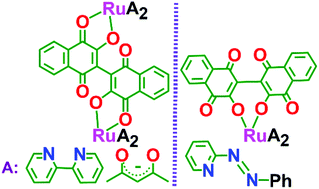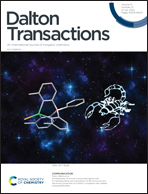Bidirectional noninnocence of hinge-like deprotonated bis-lawsone on selective ruthenium platform: a function of varying ancillary ligands†
Abstract
The present work aimed to obtain discrete heavier metal complexes of unperturbed deprotonated bis-lawsone (hinge-like H2L = 2,2′-bis(3-hydroxy-1,4-napthoquinone). This is primarily due to its limited examples with lighter metal ions (Co, Zn, and Ga) and the fact that our earlier approach with the osmium ion facilitated its functionalisation. Herein, we demonstrated the successful synthesis and structural characterisation of L2−-derived diruthenium [(bpy)2RuII(μ-L2−)RuII(bpy)2](ClO4)2 [1](ClO4)2 (S = 0), (acac)2RuIII(μ-L2−)RuIII(acac)22 (S = 1) and monoruthenium (pap)2Ru(L2−) 3 (S = 0) derivatives (bpy = 2,2′-bipyridine, acac = acetylacetonate, and pap = 2-phenylazopyridine). The crystal structures established that (i) O,O−/O,O− donating five-membered bis-bidentate and O−,O− donating seven-membered bidentate chelating modes of deprotonated L2− in rac (ΔΔ/ΛΛ) diastereomeric [1](ClO4)2, 2 and 3, respectively. (ii) The L2− bridging unit in [1](ClO4)2, 2 and 3 underwent twisting its two naphthoquinone rings with respect to the ring connecting C–C bond by 73.01°, 62.15° and 59.12°, respectively. (iii) Intermolecular π–π interactions (∼3.5 Å) between the neighbouring molecules. The paramagnetic complex 2 (S = 1) with two non-interacting Ru(III) (S = 1/2) ions exhibited weak antiferromagnetic coupling only at very low temperatures. In agreement with the magnetic results, 2 displayed typical RuIII-based anisotropic EPR in CH3CN (<g>/Δg: 2.314/0.564) but without any forbidden g1/2 signal at 120 K. The complexes exhibited multiple redox processes in CH3CN in the experimental potential window of ± 2.0 V versus SCE. The analysis of the redox steps via a combined experimental and theoretical (DFT/TD-DFT) approach revealed the involvement of L2− to varying extents in both the oxidative and reductive processes as a consequence of its bidirectional redox non-innocent feature. The mixing of the frontier orbitals of the metal ion and L2− due to their closeness in energy indeed led to the resonating electronic form in certain redox states instead of any precise electronic structural state.



 Please wait while we load your content...
Please wait while we load your content...